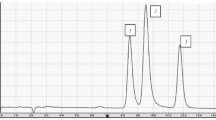Abstract
Antipyrine (AP) is a commonly used probe of oxidative metabolism. Indirect evidence demonstrates formation rate limited disposition of its metabolites. Kinetic studies using antipyrine and its major metabolites 3-hydroxymethylantipyrine (HMA), norantipyrine (NORA), and 4-hydroxyantipyrine (OHA) were completed to investigate the metabolic fate of preformed antipyrine metabolite and to demonstrate directly formation rate-limited metabolite disposition in vivo. Bolus injections of antipyrine and preformed metabolites (40-50 mg/kg) were administered to male, New Zealand white rabbits. Plasma and urine were analyzed using HPLC. These studies demonstrate that HMA, NORA, and OHA are formation rate limited in the rabbit. NORA appears to undergo further extensive oxidative and conjugative metabolism. Unknown additional peaks were detected in urine after NORA dosing but not after HMA or OHA administration. Mass spectroscopy of the unknown HPLC eluents identified potential structures of these NORA metabolites.
Similar content being viewed by others
REFERENCES
M. Danhof, A. van Zuilen, J. K. Boeijinga, and D. D. Breimer. Studies of the different metabolic pathways of antipyrine in man: Oral versus I.V. administration and the influence of urinary collection time. Eur. J. Clin. Pharmacol. 21:433–441 (1982).
M. Danhof, D. P. Krom, and D. D. Breimer. Studies on the different metabolic pathways of antipyrine in rats: Influence of phenobarbital and 3-methylcholanthrene treatment. Xenobiotica 9:695–702 (1979).
M. Danhof, R. M. A. Verbeek, C. J. van Boxtel, J. K. Boeijinga, and D. D. Breimer. Differential effects of enzyme induction on antipyrine metabolite formation. Br. J. Clin. Pharmacol. 13:379–386 (1982).
A. Nakagawa, K. Nakamura, K. Maeda, T. Kamataki, and R. Kato. Studies on in vitro antipyrine metabolism by 13C, 15N-double labelled method. Life Sci. 41:133–143 (1987).
M. W. E. Teunissen, C. H. Kleinbloesem, L. G. J. de Leede, and D. D. Breimer. Influence of cimetidine on steady state concentration and metabolite formation from antipyrine infused with a rectal osmotic minipump. Eur. J. Clin. Pharmacol. 28:681–684 (1985).
M. W. E. Teunissen, P. Spoelstra, C. W. Kock, B. Weeda, W. van Duyn, A. R. Janssens, and D. D. Breimer. Antipyrine clearance and metabolite formation in patients with alcoholic cirrhosis. Br. J. Clin. Pharmacol. 18:707–715 (1984).
W. M. Awni, J. V. St. Peter, J. M. Kovarik, and G. R. Matzke. Disposition of antipyrine and acetaminophen given alone and in combination to human subjects. Pharm. Res. 7:204–207 (1990).
A. R. Boobis, M. J. Brodie, G. C. Kahn, E.-L. Toverud, I. A. Blair, S. Murray, and D. S. Davies. Comparison of the in vivo and in vitro rate of formation of the three main oxidative metabolites of antipyrine in man. Br. J. Clin. Pharmacol. 12:771–777 (1981).
S. K. Bowles, L. Cardozo, and D. J. Edwards. Quinidine does not alter antipyrine metabolism. J. Clin. Pharmacol. 30:267–271 (1990).
W. Buijs, B. van Meeteren-Walchli, D. D. Breimer, and A. van der Gen. An improved synthesis of 3-hydroxymethylantipyrine using antipyrine as starting material. Arzneimittel-Forschung 36:419–421 (1986).
D. M. Chambers and G. C. Jefferson. Effects of drug pretreatment on antipyrine elimination in the rabbit. Pharmacology 24:88–95 (1982).
G. Taylor and J. B. Houston. Changes in the disposition of promethazine during multiple dosing in the rabbit. J. Pharm. Pharmacol. 37:243–247 (1985).
J. W. Paxton. Absence of effect of propoxyphene on antipyrine kinetics in the rabbit. Pharmacology 27:241–244 (1983).
A. van Peer, F. Belpaire, and M. Bogaeret. Pharmacokinetics of drugs with experimental acute renal failure. Pharmacology 17:307–314 (1978).
B. E. Statland, P. Astrup, C. H. Black, and E. Oxholm. Plasma antipyrine half-life and hepatic microsomal antipyrine hydroxylase activity in rabbits. Pharmacology 10:329–337 (1973).
B. B. Brodie and J. Axelrod. The fate of antipyrine in man. J. Pharmacol. Exp. Ther. 98:97–104 (1950).
J. V. St. Peter and W. M. Awni. Modified high-performance liquid chromatographic assay for antipyrine and its three major metabolites in urine. J. Chromatogr. Biomed. Appl. 494:424–427 (1989).
H. Uchino, T. Inaba, and W. Kalow. Human metabolism of antipyrine labelled with 14C in the pyrazolone ring or in the N-methyl group. Xenobiotica 13:155–162 (1983).
J. Bottcher, H. Bassmann, and R. Schuppel. Identification of sulfates in antipyrine metabolism in man, rat, and rabbit. Drug Metab. Disp. 10:90–91 (1982).
H. Monig, J. Wilhelmy, S. John, and E. E. Ohnhaus. Biliary excretion of antipyrine and its metabolites after cholecystectomy. Br. J. Clin. Pharmacol. 25:279–280 (1988).
P. S. Wissel and A. Kappas. The absence of significant biliary excretion of antipyrine or its metabolites in humans. Clin. Pharmacol. Ther. 41:85–87 (1987).
Author information
Authors and Affiliations
Rights and permissions
About this article
Cite this article
St. Peter, J.V., Abul-Hajj, Y. & Awni, W.M. The Pharmacokinetics of Antipyrine and Three of Its Metabolites in the Rabbit: Intravenous Administration of Pure Metabolites. Pharm Res 8, 1470–1476 (1991). https://doi.org/10.1023/A:1015830013451
Issue Date:
DOI: https://doi.org/10.1023/A:1015830013451




